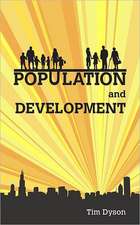Ageing in Advanced Industrial States: Riding the Age Waves - Volume 3: International Studies in Population, cartea 8
Editat de Shripad Tuljapurkar, Naohiro Ogawa, Anne H. Gauthieren Limba Engleză Paperback – 5 sep 2012
This is the final volume in a series of three. The papers included explore many examples and strengthen the basis for effective economic and social policies by investigating the economic, social, and demographic consequences of the transformations in the structures of population and family. These consequences include changes in economic behavior, both in labor and financial markets, and with regard to saving and consumption, and intergenerational transfers of money and care.
| Toate formatele și edițiile | Preț | Express |
|---|---|---|
| Paperback (2) | 424.22 lei 6-8 săpt. | |
| SPRINGER NETHERLANDS – 14 aug 2018 | 424.22 lei 6-8 săpt. | |
| SPRINGER NETHERLANDS – 5 sep 2012 | 737.93 lei 38-44 zile | |
| Hardback (1) | 649.22 lei 6-8 săpt. | |
| SPRINGER NETHERLANDS – 3 iun 2010 | 649.22 lei 6-8 săpt. |
Preț: 737.93 lei
Preț vechi: 970.97 lei
-24% Nou
Puncte Express: 1107
Preț estimativ în valută:
141.20€ • 147.43$ • 116.86£
141.20€ • 147.43$ • 116.86£
Carte tipărită la comandă
Livrare economică 01-07 aprilie
Preluare comenzi: 021 569.72.76
Specificații
ISBN-13: 9789400732254
ISBN-10: 9400732252
Pagini: 348
Dimensiuni: 155 x 235 x 18 mm
Greutate: 0.49 kg
Ediția:2010
Editura: SPRINGER NETHERLANDS
Colecția Springer
Seria International Studies in Population
Locul publicării:Dordrecht, Netherlands
ISBN-10: 9400732252
Pagini: 348
Dimensiuni: 155 x 235 x 18 mm
Greutate: 0.49 kg
Ediția:2010
Editura: SPRINGER NETHERLANDS
Colecția Springer
Seria International Studies in Population
Locul publicării:Dordrecht, Netherlands
Public țintă
ResearchDescriere
Population
growth
slowed
across
the
world
in
the
last
decades
of
the
20thcentury,
changing
substantially
our
view
of
the
future.
The
21stcentury
is
likely
to
see
the
end
to
world
population
growth
and
become
the
century
of
population
aging,
marked
by
low
fertility
and
ever-increasing
life
expectancy.
These
trends
have
prompted
many
to
predict
a
gloomy
future
caused
by
an
unprecedented
economic
burden
of
population
aging.
In
response,
industrialized
nations
will
need
to
implement
effective
social
and
economic
policies
and
programs.
This is the final volume in a series of three. The papers included explore many examples and strengthen the basis for effective economic and social policies by investigating the economic, social, and demographic consequences of the transformations in the structures of population and family. These consequences include changes in economic behavior, both in labor and financial markets, and with regard to saving and consumption, and intergenerational transfers of money and care.
This is the final volume in a series of three. The papers included explore many examples and strengthen the basis for effective economic and social policies by investigating the economic, social, and demographic consequences of the transformations in the structures of population and family. These consequences include changes in economic behavior, both in labor and financial markets, and with regard to saving and consumption, and intergenerational transfers of money and care.
Cuprins
Introduction:
Shripad
Tuljapurkar,
Naohiro
Ogawa,
and
Anne
Gauthier.-1:
Age-Structural
Transitions
in
Industrialized
Countries:
Ian
Pool.-
2:
On
Age
Structures
and
Mortality:
Nico
Keilman.-3:
Long-Run
Relationships
in
Differential
U.S.
Mortality
Forecasts
by
Race
and
Sex:
Tests
for
Cointegration:
Lawrence
Carter.-
4:
Uncertain
Demographic
Futures
and
Government
Budgets
in
the
U.S.:
Ronald
Lee,
Shripad
Tuljapurkar,
Ryan
Edwards.-
5:
Life,
Death,
and
the
Economy:
Mortality
Change
in
Overlapping-Generations
Model:
Qi
Li
and
Shripad
Tuljapurkar.-
6:
International
Adverse
Selection
in
Life
Insurance
and
Annuities:
David
McCarthy,
Olivia
S.
Mitchell.-
7:
Aging,
Family
Support
Systems,
Saving,
and
Wealth:
Is
Decline
on
the
Horizon
for
Japan?:
Andrew
Mason,
Naohiro
Ogawa,
Takehiro
Fukui.-
8:
The
Future
Costs
of
Health
Care
in
Aging
Societies:
Is
the
Glass
Half
Full
or
Half
Empty?:
Deborah
Freund,
Timothy
Smeeding.-
9:
Family
Support
for
Older
People:
Determinants
and
Consequences:
Emily
Grundy.-
10:
Care
of
the
Elderly
and
Women’s
Labour
Force
Participation
in
Japan:
Naohiro
Ogawa,
Robert
Retherford,
Yasuhiko
Saito.-
11:
Family
and
Kinship
Networks
in
the
Context
of
Ageing
Societies:
Michael
Murphy.-
12:
Historical
Trends
in
the
Patterns
of
Time
Use
of
Older
Adults:
Anne
Gauthier,
Timothy
Smeeding.-
13:
An
Economic
Analysis
of
Age
Discrimination
–
The
Impact
of
Mandatory
Retirement
and
Age
Limitations
in
Hiring
on
the
Utilization
of
Human
Resources
in
an
Aging
Society:
Atsushi
Seike
Textul de pe ultima copertă
Population
growth
slowed
across
the
world
in
the
last
decades
of
the
20thcentury,
changing
substantially
our
view
of
the
future.
The
21stcentury
is
likely
to
see
the
end
to
world
population
growth
and
become
the
century
of
population
aging,
marked
by
low
fertility
and
ever-increasing
life
expectancy.
These
trends
have
prompted
many
to
predict
a
gloomy
future
caused
by
an
unprecedented
economic
burden
of
population
aging.
In
response,
industrialized
nations
will
need
to
implement
effective
social
and
economic
policies
and
programs.
This is the final volume in a series of three. The papers included explore many examples and strengthen the basis for effective economic and social policies by investigating the economic, social, and demographic consequences of the transformations in the structures of population and family. These consequences include changes in economic behavior, both in labor and financial markets, and with regard to saving and consumption, and intergenerational transfers of money and care.
This is the final volume in a series of three. The papers included explore many examples and strengthen the basis for effective economic and social policies by investigating the economic, social, and demographic consequences of the transformations in the structures of population and family. These consequences include changes in economic behavior, both in labor and financial markets, and with regard to saving and consumption, and intergenerational transfers of money and care.
Caracteristici
Is
unique
in
its
breadth
of
international
and
comparative
analysis
Considers the three key policy dimensions: health, economics, and demography
Takes a close look at social and cultural change and the effects on behavior
Presents a broad cross-country comparison of trends in demography and health
Explores policy implications of quantitative and qualitative shifts in family and society
Considers the three key policy dimensions: health, economics, and demography
Takes a close look at social and cultural change and the effects on behavior
Presents a broad cross-country comparison of trends in demography and health
Explores policy implications of quantitative and qualitative shifts in family and society


























